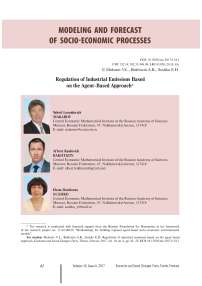Regulation of industrial emissions based on the agent-based approach
Автор: Makarov Valerii Leonidovich, Bakhtizin Albert Raufovich, Sushko Elena Davidovna
Журнал: Economic and Social Changes: Facts, Trends, Forecast @volnc-esc-en
Рубрика: Modeling and forecast of socio-economic processes
Статья в выпуске: 6 (54) т.10, 2017 года.
Бесплатный доступ
The article demonstrates one of the most advanced methods for regulation of industrial emissions, which is used by governments of different countries - an emissions trading system based on the bubble principle. This method is a tool for incentive-based control to encourage businesses to reduce the burden on the environment, providing emissions limits of harmful substances, but at the same time giving them some freedom to choose the methods to achieve the specified emission standards. To create a domestic comprehensive system for emissions regulation it would be useful to use the instruments for preliminary evaluation of effects from the implementation of various control measures. One of such instruments may be the agent-based regional model developed by the authors in the present paper. The model will help test different combinations of control measures - both administrative and market - with the use of computer experiments in order to find a balanced combination. The model simulates production activity of agent enterprises which employ agent people...
Agent-based model, air pollution, market-based instrument, bubble principle, emissions trading, incentive-based control
Короткий адрес: https://sciup.org/147224007
IDR: 147224007 | УДК: 332.14; | DOI: 10.15838/esc.2017.6.54.3
Текст научной статьи Regulation of industrial emissions based on the agent-based approach
The issue of reducing the anthropogenic load on the environment in general and reducing pollutant emissions into the atmosphere in particular has been relevant in the past decades. A huge step to addressing the issue across the planet was the adoption in 1997 of the Kyoto Protocol – an international agreement which obliges developed countries and transition economies to reduce or stabilize greenhouse gas emissions. Under the Kyoto Protocol, Russia committed itself to stabilize average annual emissions to the level of 1990 and managed to exceed the target, reducing emissions from the power sector by 37% in 20 years. With regard to Russia’s international obligations, the country currently does not plan to participate in activities to implement the Protocol. However, within the country, the objective of reducing emissions remains relevant as the issues associated with high levels of polluting substances in the atmosphere remain in many industrialized regions of the country (according to the observations of Voeikov Main Geophysical Observatory, in 243 Russian cities in 2016, 20 of them were included in the list of cities with very high levels of air pollution, 24 of them were highly polluted1). Therefore, to address this important issue it is required to use all possible administrative and economic corrective measures for polluting enterprises, especially measures which are not only justified from the point of view of the economic theory but which proved its effectiveness in practice.
The works [3; 22] present the analysis of different management mechanisms of environmental-economic systems including optimization, game-theoretic and simulation models. The work [3] considers in detail a wide range of measures from introduction of monitoring systems, systems of compensation of costs of reducing risks, penalties to systems of economic motivation for enterprises to improve their environmental behavior such as emissions trading. It should be emphasized that the Kyoto Protocol also provides for the use of the so-called flexibility mechanisms including emissions trading which implies that states or its individual economic entities can sell or buy quotas for greenhouse gas emissions at national, regional or international markets.
The emissions trading mechanism is based on the so-called “bubble principle” which aims to maintain the target level of pollution in the region allowing businesses in the region (“bubble”) which managed to reduce total pollutant emissions below the specified level to sell excess emission reductions to region’s enterprises which exceeded its quota. This is indeed a mechanism of flexibility since it helps businesses choose the most economically feasible strategy to achieve specified environmental standards. Businesses are given a choice to pay fines, buy/sell emissions quotas, install cleaning equipment or upgrade the production itself, etc. while retaining the total environmental load within the region. Corresponding quota banks are established for implementing the emissions trading mechanism.
It is important to note that the mechanism is quite effective from the overall societal point of view as it helps achieve environmental goals in the most cost-effective manner.
The specified advantages of the bubble principle mechanism have made it so attractive that attempts are being made to adapt it for using, for example, in regulating disposal of sewage into water bodies (see, for example, [8]).
At present, different countries have vast practical experience in the implementation of market-based systems of regional air pollution regulation. The experience of the U.S. is the most indicative in this respect, the analysis of which is viewed in detail.
The sulphur dioxide (SO2) emissions trading program launched in the U.S. in accordance with Title IV of the 1990 U.S. Clean Air Act (CAA) Amendments2 was the world’s first large-scale system of pollutant emissions control and trading. The stated purpose of the Acid Rain Program (ARP)3 was to reduce total annual SO2 emissions in the U.S. by ten million tons compared to 1980 when total emissions were around 26 million tons. Unlike conventional environmental legislation, the law did not provide for how enterprises were to reduce SO2 emissions. Instead, the first stage of the Program in 1995–2000, restrictions were imposed on total SO2 emissions at 3,200 coal plants in the country; the government established the market of government-issued SO2 emissions permits which could be bought and sold. As a result, by 2007, total annual emissions declined slightly below the stated target level of the Program (a nine million ton decline, which amounted to 43%, compared with the levels of 1990), yet electricity generation at coal power stations increased from 1990 to 2007 by more than 26%4.
As for the actual Acid Rain compliance costs, although they exceeded the level ideal from the point of view of economic efficiency, they were still significantly below the estimates claimed by government analysts during discussions which preceded the launch of the Program. One of the reasons for such results may have been the underestimated influence of high prices of SO2 emissions. High price of emissions was an impetus for the introduction of technological innovation in the industry in terms of both atmospheric emissions treatment systems and exploitation of power plants, which reduced the costs during the period [9; 19; 21].
In Figures 1, 2 the circles on the mapscheme of the U.S. demonstrate SO2 emissions in the territory of each state as of 1990 and 2015 (the radius of the circle depends on the amount of emissions in thousand tons). The green background reflects states which participated in programs for air pollution control Acid Rain (ARP), and Cross-State Air Pollution Rule (CSAPR), which controlled emissions of fine particles. In addition, there is a diagram on the right demonstrating the performance of the indicator for the entire period for the selected State of Ohio with the maximum levels of emissions at the beginning of the period and the most impressive reduction – 92% (from 2211.6 thousand tons in 1990 to 177.3 thousand tons in 2015).
For more detail about the experience of implementing market-based systems of regional atmospheric pollution control in different countries see [1; 10; 11; 18]. Analysis of the practically obtained results demonstrates the effectiveness and efficiency of such systems, hence the feasibility of implementing a similar emissions control system in Russia. It is obvious that the development of complex atmospheric emissions control measures in Russia requires the use of best foreign experience and the study of local characteristics both technological and institutional. The use of tools for preliminary assessment of effects from the implementation of various control measures would be the most helpful when creating a national integrated system of emissions control. In this regard, special attention should be paid to methods of simulation modeling as this approach helps in the course of computer experiments test different combinations of control measures – both administrative and market – and find a balanced combination.
Among modern approaches to simulation of large socio-economic systems the most appropriate is the agent-based approach [5; 7; 15]. The terminology of V.N. Burkova [2] considers a large (or active) system in this case as a system including independent actors acting in accordance with their interests and abilities. The agent-based approach simulates the actions of individual independent actors (represented by agents in an agent-based model); the state
Figure 1. SO 2 emissions distribution map in the U.S. States, 1990
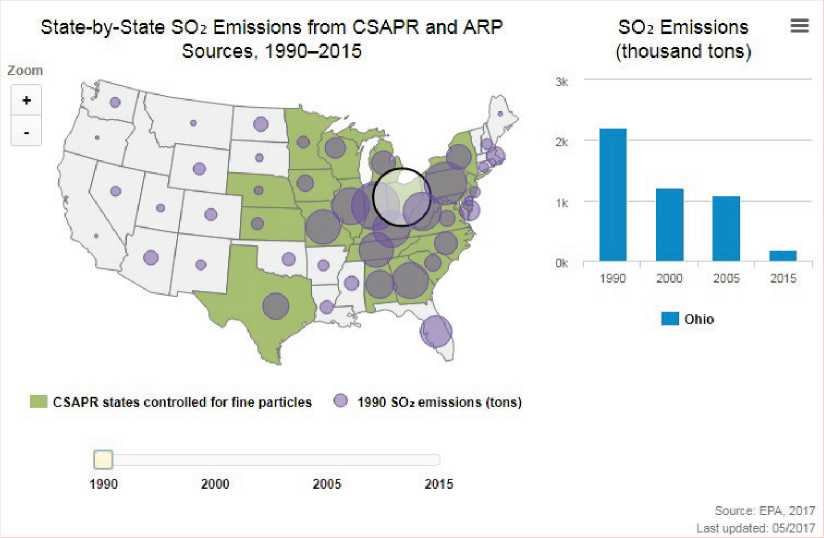
Source: U.S. EPA (United States Environmental Protection Agency). Emission reductions. 2017. Available at: https://www3.
Figure 2. SO 2 emissions distribution map in the U.S. States, 2015
State-by-State SOz Emissions from CSAPR and ARP Sources. 1990-2015
Zoom
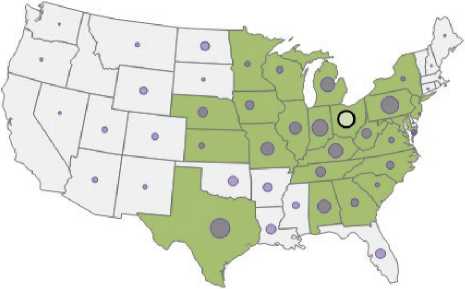
■ CSAPR states controlled for fine particles • 2015 SOi emissions (tons)
SO? Emissions (thousand tons)
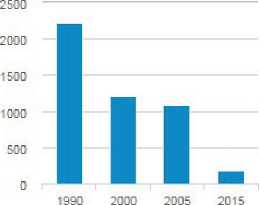
■ Ohio

Source: ERA. 2017
Last updated: 05/2017
Source: U.S. EPA (United States Environmental Protection Agency). Emission reductions. 2017. Available at: https://www3.
of the overall system is the integrated result of actions and interactions of these agents. The autonomy of agents means that they have certain resources (opportunities), a mission and relevant criteria for its completion, as well as the ability to make decisions on selecting an action from the available options. It is necessary to emphasize that the agent-based model (ABM) can create an indefinitely large number of agents with individual characteristics meaningful in terms of their participation in economic life; the values of these characteristics can vary for each agent. It is exactly the “bottom-up” construction of a digital analogue of the real large socio-economic system that makes it possible to recreate all the features of its social structure in an artificial environment and achieve maximum likelihood when simulating the processes taking place within.
A brief overview of environmental and economic ABMs
Many literary sources widely present ABMs which simulate the processes associated with land cultivation, fishing and other human activities which directly use natural resources and affect the environment of places of people’s residence through overexploitation of these resources. These activities often increase the risk of natural resource depletion and environmental disasters on a local scale.
In [13], agent-based models designed to simulate and analyze various processes related to environmental management in different Asian countries are reviewed in a separate chapter. The presented model helps analyze the mutual influence of social processes and performance of environmental parameters of territories and is designed to search for a rational compromise between the interests of people engaged in various types of human activities in order to prevent land degradation and achieve balanced use of renewable resources.
Examples of research contributing to the solution of such issues are the two ABMs designed for setting up computer experiments and providing recommendations for selecting a more effective form of financial support for the rural population from the point of view of natural resources management, and investing in the development of agricultural territories. The research concerns the study of specific nature of labor management of the life of the rural population in small Asian countries – Nepal and Thailand – which are dependent on the region’s climate conditions (rain periods) and the underdeveloped infrastructure. The first model presented in [14] reproduces complex interrelations of objects of socio-environmental-economic system of Nepal. The key features of the model are: a) simulation of population migration caused by the low standard of living; b) use of the social capital construction which takes into account human relations, patterns of behavior, etc. which facilitate collective actions; and c) the recreation of water storage features, the reconstruction of which is able to improve yields in dry-weather periods and thereby increase the standard of living of the rural population.
The experiments have enabled the model’s authors to forecast the results for ten years for each rural settlement and for each form of investment taking into account different climate scenarios, which can help shape the best strategy for the development of these settlements.
The second model presented in [20] also aims to develop the program of government investment (in this case Thailand) for construction of water supply and drainage infrastructure. An important requirement to the Program is its sustainability taking into account the specific nature of labor activities of the rural residents. The model has been tested in experiments, preliminary results have been obtained.
We also mention another ABM presented in the work of Russian authors [4]. It is a conceptual model of a multi-agent system of environmental security management with agents of the environmental-economic system with rather complex design (intelligent agents) able to cooperate when developing the management mechanisms and coordinate activities at different levels of the hierarchy, starting with companies’ agents and ending with the supervisor agent represented by the government. The supervisor agent has the power to change the rules of the game for companies’ agents, namely, change restrictions on emissions, fines for exceeding permissible emissions levels. The decisions of companies’ agents are to choose the strategy of investment in environmental activities – distributed in sequence time of investments, ensuring the achievement of environmental standards by a specific point in time. Data on testing the model are unfortunately not given in the work.
The literature, albeit in much smaller quantities, also presents the ABMs devoted to the issue of pollutant emissions trading. The present paper mentions two of these models.
The first ABM presented in [16; 17] is designed to analyze the impact of various regulatory measures and cap-and-trade on water emissions and water quality along the coastline of Australia. Pollutant emissions into water create problems for maintaining healthy marine ecosystems, which in turn affects land use conditions. The agents in the model do gardening or sugar cane cultivation; the cultivation of these crops has different impacts on the environment. The model interface at each step of simulation clearly demonstrates the current state of the entire simulated ecosystem on the map and helps the user manipulate many parameters in the course of computer experiments (such as crop yields, prices, etc., the total of more than 15 parameters) in order to assess the implications of various scenarios. Figure 3 demonstrates the interactive interface of the model including a spatial map with the boundaries of the selected plots and houses on them. The top left corner has the model’s start button. On the left, there are control buttons – sliders and switches, each associated with one of the options. The switch helps the user select one of the given values of parameters (for example, activate or deactivate emissions trading mode); by moving the slider the user can increase/ decrease the values of corresponding parameters in the model. At the top right of the interface, graphic materials demonstrate the performance of modeling results during simulation (quota, prices, supply and demand curves, traded value, etc., the total of eight graphs).
[12] presents an agent-based model which simulates the behavior of electricity industries and the impact of the CO2 emissions trading policy on this behavior, which in Europe is one of the main tools for achieving agreed goals of reducing CO2 emissions (in Europe, power generation accounts for one third of CO2 emissions). The corresponding
Figure 3. Interactive interface of the model
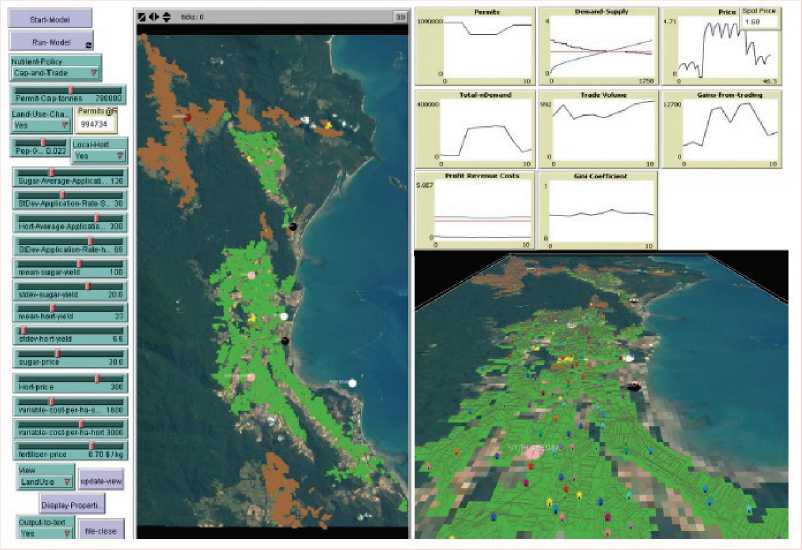
Source: S. Heckbert Agent-based modelling of emissions trading for coastal landscapes in transition. Journal of Land Use Science, 2011, vol. 6, no. 2–3, p. 140.
Program has been implemented since 2005. Companies’ agents in the model can buy/sell emissions quota, as well as invest in changing production technology, shifting it towards using other low-carbon energy sources. The experiments indicate a certain influence of the government policy on changes in the structure energy source enterprises use – a long-term shift of the structure towards more intensive low-carbon power generation. However, this effect is relatively insignificant and is often greatly delayed. In most scenarios, absolute emissions from power generation are increased, which corresponds to the observed trend of increasing current capacity through establishing new coal power plants. Apparently in power generation, the economic effect of CO2 emissions trading is insufficient to outbalance economic incentives for choice of coal. Figure 4 demonstrates the performance of the structure (portfolio distribution, %) of power sources used by enterprises of the European Union in the presence of emissions trading (emissiontrading, indicated by a full line) and without it (no emission-trading, indicated by a dashed line), gray arrows indicate changes caused by the policy implementation (impact by CET). The following types of power plants are presented: nuclear, wind, biomass, gas, and coal; the share of imports is also reflected. The figure suggests that the main types of applied energy sources are natural gas and coal; with the share of coal growing steadily
Figure 4. Performance of the structure of power sources used by EU companies and the influence of CO2 emissions trading system on it
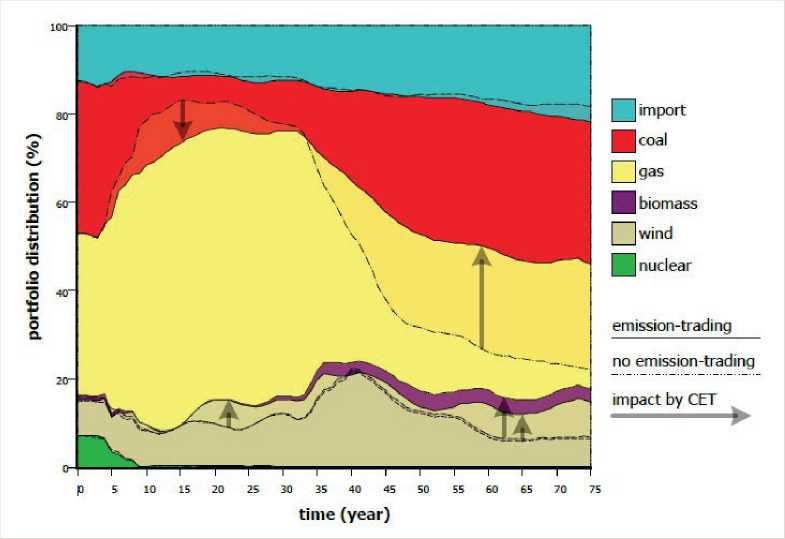
Source: Chappin E. J. L., Dijkema G. P. J. On the Impact of CO2 Emission-Trading on Power Generation Emissions. Technological Forecasting & Social Change, 2009, no. 76, p. 367.
by the end of the forecast period and in both scenarios, although the emissions trading system significantly slows down this growth.
Analysis of economic methods of environmental management and experience in the application of the agent-based approach to the modeling of these processes stimulated the authors to develop their own agent-based model for testing various strategies for the implementation of the bubble principle in regional management. Thus, the purpose for the study was to develop a regional agent-based model recreating the internal structure and the regulations of a region as a complex socio-environmental-economic system including independently operating large economic actors
– enterprises; and simulating the response of these actors on emissions control. The ABM serves as a tool for preliminary assessment of effects of implementing various control measures.
The model of environmental behavior control for companies’ agents
Environmental behavior of enterprises in the article refers to as management of emissions of harmful substances generated during the production process. The conceptual framework of the agent-based model for enterprises’ environmental behavior management developed in CEMI RAS (Central Economic Mathematical Institute of the Russian Academy of Sciences) includes the following provisions:
-
• The system of enterprise environmental behavior management simulated in the model must be comprehensive and must include both administrative and economic measures of influence on companies’ agents.
-
• The system must encourage enterprises to reduce total regional emissions.
-
• The system must be flexible enough to provide the choice of behavior strategies for enterprises in compliance with the standards of the environmental status of the region as a whole.
-
• From the point of view of the control center (which is represented by the user of the ABM), it must be sufficiently transparent and efficient.
The above-described mechanism of the bubble principle, which was tested in practice and proved its effectiveness, meets all these requirements.
The technological framework for the designed agent-based models of enterprise environmental behavior management was the construction of the regional socio-environmental-economic agent-based model presented in article [6]. Figure 5 demonstrates a generalized scheme of the mutual influence of agents and their environment in the regional agent-based model with broad arrows indicating the directions of resource transfer and thin arrows – the directions of information flows.
Figure 5. Scheme of mutual influence of agents and their environment in the region’s agent-based model
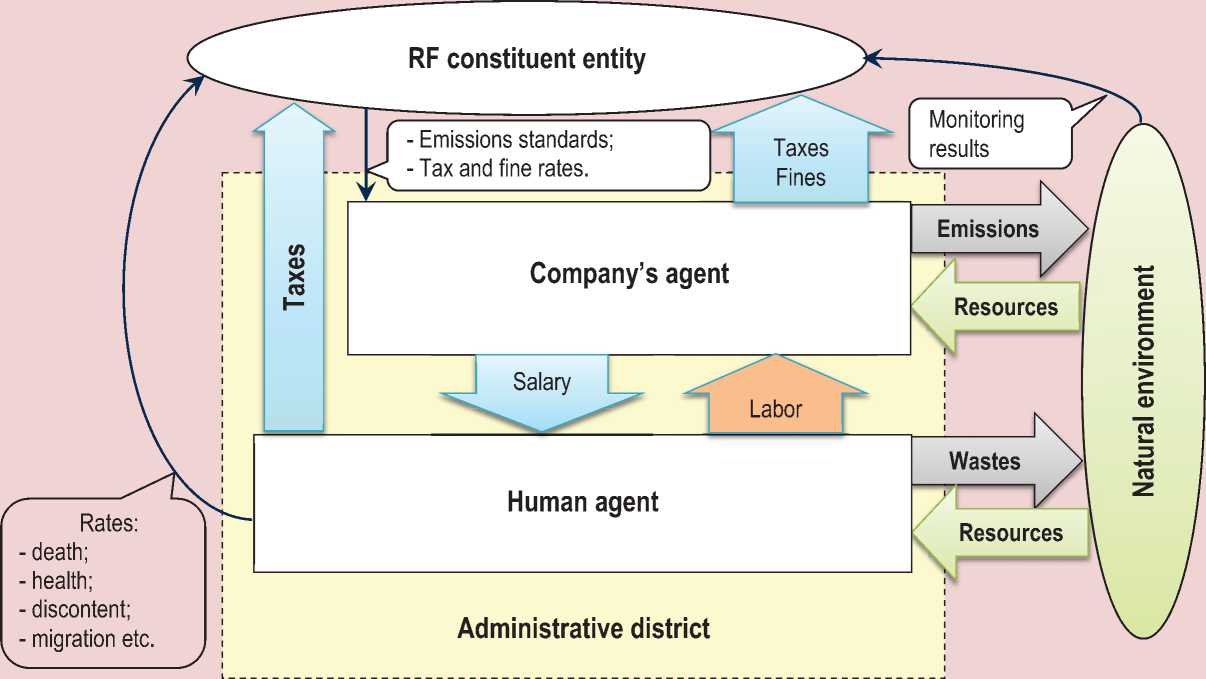
Source: Makarov V.L., Bakhtizin A.R., Sushko E.D. Agent-orientirovannaya sotsio-ekologo-ekonomicheskaya model’ regiona [Agent-based socio-environmental economic model of a region]. Natsional’nye interesy: prioritety i bezopasnost’ [National interests: priorities and security], 2015, no. 3, pp. 2–11.
The article is focused on the development of mechanisms to simulate the impacts of people’s activities – its residents and companies located in its territory – on the region’s environment in an agent-based model, as well as reciprocal influence of the state of the region’s environment on the health and mood of its residents.
The present work, developing the specified socio-environmental-economic model, also focuses on providing the realistic simulation within the framework of the ABM of various strategies of environmental behavior of companies’ agents associated with their participation in the emissions trading system. To achieve this goal we developed a rather complicated structure of a company’s agent and consequently complicated the agents’ environment. The model consists of formal structures (“classes” in the terminology of modern object-oriented programing) corresponding to actors (agents) involved in the emissions trading process and objects of the external environment. The classes of subject agents differ from object agents in that apart from the characteristics of the content of the real world important to the objectives set out in the model they also include software modules (“methods”) which implement the procedure for simulating agents’ behavior in a particular class. When starting, the model creates populations of agents and many objects – examples of each class of the model with individual values of specified characteristics.
The class system of the ABM:
-
• Class of companies’ agents
-
a) features:
-
• enterprise’s index;
-
• name;
-
• industry affiliation, type of activity (index);
-
• number of employees;
-
• production volume;
-
• administrative affiliation (index);
-
• object – image of an enterprise on the region’s geographical map;
-
• location on a geographical map of the region-source of emissions;
-
• planning horizon;
-
• technological level (on a scale);
-
• net emissions by main types of gases;
-
• emissions by type;
-
• emissions quota by type;
-
• list of types of emissions not limited by quota ( Q +);
-
• list of types of emissions with exceeded quota ( Q -);
-
• fines for exceeding emissions by type and total;
-
• income from emissions trading by type and total;
-
• cost of installing filter trap systems;
-
• cost of upgrading;
-
• list (collection) of human agents – enterprise employees;
-
b) motivation: to reduce total costs over the entire planning period associated with compliance with the regional environmental requirements.
-
c) types of actions available to the agent:
-
• selling free emission quotas if the enterprise’s emissions are below the set quota;
-
• purchase of missing emissions quota if enterprise’s emissions exceed the set quotas;
-
• fines for exceeding emissions quota;
-
• installation of filters reducing atmospheric emissions;
-
• modernization of production in order to move to the next technological level of emissions reduction.
-
d) methods (procedure):
-
• procedure for calculating total costs over the entire planning period for different variants of activities;
-
• procedure for comparing different options and selecting the best with least total costs.
-
• Class of regions
-
• unique number;
-
• name;
-
• geographical map of the region;
-
• point of monitoring of atmosphere pollution on the map;
-
• levels of pollution by type of emissions;
-
• price of quota per unit of emissions by type;
-
• sales of emissions quota (emissions bank) by type;
-
• revenues from fines for emissions by type;
-
• reduction factor in the resolution on emissions trading ( a );
-
• number of companies’ agents;
-
• list (collection) of companies’ agents.
-
• Class of emissions
-
• index of the type of emissions;
-
• name;
-
• permissible concentration;
-
• unit cost of filter installation;
-
• fines for pollution;
-
• price of a quota per unit of emissions.
-
• Class of activities
-
• index of activity type;
-
• name;
-
• number of technological levels;
-
• production function as dependence of production volume on the number of employees in technological levels;
-
• financial costs of transferring production to the next technological level (by technological level);
-
• time required to transfer production to the next technological level (by technological level);
-
• minimum and maximum emissions per unit of production by type of emissions and technological level.
The overall management of the model is implemented by the main class . It provides initial data entry; creates populations of agents and examples of other model classes of a specified number; sets the initial state of the system corresponding to the base year of simulation; displays the status of agent populations and other general indicators of the model on the screen; arranges dialogue with the user; organizes the process of simulation at each step. In addition, each class with a collection of agents also contains the method for gathering statistics on this collection for generalized indicators.
The class of human agents in the model ensures reproduction of the population and its labor potential but it is not involved in the process of emissions trading, so we do not describe it in detail – its design matches the design of human agents from [6].
Let us now consider how the process of emissions trading is implemented in our regional ABM according to the bubble principle. The general scheme of the algorithm of behavior of a company’s agent at each step of simulation is demonstrated in Figure 6 .
This procedure is repeated for each company’s agent from the population of agents of this type:
-
B1 . Activation of the selected company agent at the current step of simulation.
Figure 6. General scheme of behavior of a company’s agent
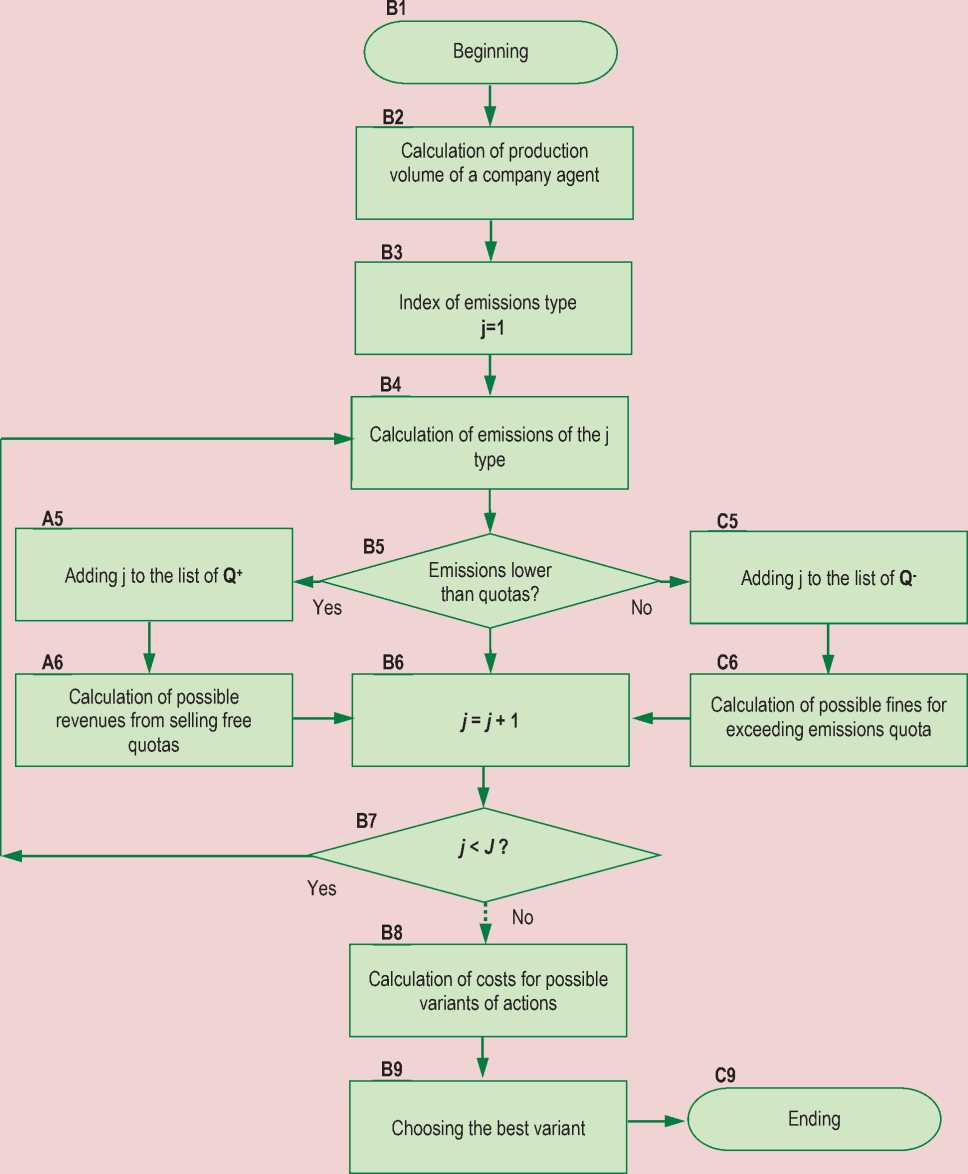
-
B2 . In this block, using the production function, we calculate the volume of production of a company agent at the current number of agent workers and the level of technological development.
-
B3 . The beginning of the cycle which sequentially examines each type of emissions j ( j = [1, J ], where J – number of types of emissions associated with production technology).
-
B4 . The calculation of emissions of the j type corresponding to the volume of production and specific emissions of this type at the current technological level of the enterprise.
-
B5 . The unit for comparing the amount of emission of the j type with the enterprise’s corresponding quota. If the amount of emissions is below the quota transition to unit A5 takes place , and then to A6 where the j type is added to the list of Q+ ; revenues from selling unused quotas are calculated. If the amount of emissions exceeds the quota transition to unit C5 , and then to C6 takes place, where the j type is added to the list of Q- ; fines for exceeding quotas are calculated. In both cases, there is a transition to the next type of emissions (unit B6 ); if all types are considered then the cycle ends.
The actions of the company agent are reproduced in the model in two stages. At the first stage, all agents of the population determine the amount of quota for selling or buying, which forms the bank of emissions quota of different types (at this stage, all the above described units for each agent are implemented). After that the agents proceed to analysis of conditions of implementation of various available behavior strategies and select the best one (units B8 – B9 ).
In Figure 6 the transition from one stage of agent’s behavior to another is underlined with a dotted arrow between blocks B7 and B8 .
-
B8 . The calculation of costs for possible variants of agents’ actions. The enterprise’s costs in the model consist of: a) fines for exceeding emissions quota from the list of Q- ; b) cost of purchase of missing emissions quota from the same list; c) cost of filters trapping contaminants and reducing emissions; d) cost of modernization helping the company to move to a new technological level which reduces net emissions.
The enterprise can fully or partially compensate for these expenses by receipts from proceeds form selling surplus emissions quota from the list of Q+ including those occurring after the installation of filter traps or modernization of production.
The calculation of costs is carried out for the entire period corresponding to the agent’s planning horizon. It is obvious that to consider an option such as modernization the planning horizon should be considerably bigger than the period of the implementation in order to return modernization costs.
It should also be noted that the policy of the center (in this case, the region) aims to reduce the overall level of pollution, therefore the reduction factor is introduced: 0 < a < 1; it is multiplied by the sold emissions quota in the quota bank. The factor may vary for different emission types depending on the overall level of pollution and the policy of regional authorities.
-
B9 . The comparison of the calculated impacts of various options available to the agent and choosing the best one which minimizes the total costs over the planning
horizon. It is important that the ABM consistently simulates the behavior of each company’s agent; the sequence is set randomly. In the end the choice of agents which happened to be at the beginning of the process may narrow down the choices for the remaining agents (e.g., if quotas are already sold out).
The model then simulates the implementation of the variant. For example, if an agent made a decision about modernization of production during the implementation period of the project to transfer production to the next technological level, the agent continues to pay fines (or buy quotas if it is more profitable), at the end of this period it changes its technological level and the characteristics of the production function and net emissions of different types at the same time. The following stages of simulation use new values of these characteristics for calculations.
C9 . The completion of agents’ actions at the stage.
Obviously, total costs and hence attractiveness of this or that variant for the agent depends on the level of fines for exceeding quotas and values of factor for different types of emissions. It is these values that are controlled by the model parameters, varying which in the course of computer experiments the user can test different variant of their ratio for obtaining maximum effect from the implementation of the mechanism of the bubble principle.
The design of the AOM was implemented as a separate unit of a large socio-environmental-economic model and tested on conditional data on the level of fines, emissions, emissions quotas, and the cost of modernization. Experiments were carried out for multiple, conditional enterprises in the region of the same industry with different level of technological development. All of these conditions of experiments have a significant impact on the result; therefore, although the model demonstrated an adequate response to the variation of its parameters, the results are preliminary so far. After adapting the model to specific conditions of the region it can be used at the level of regional authorities.
Список литературы Regulation of industrial emissions based on the agent-based approach
- Averchenkov A.A., Galenovich A.Yu., Safonov G.V., Fedorov Yu.N. Regulirovanie vybrosov parnikovykh gazov kak faktor povysheniya konkurentosposobnosti Rossii . Moscow: NOPPPU, 2013. 88 p..
- Burkov V.N., D.A. Novikov Teoriya aktivnykh sistem: sostoyanie i perspektivy . Moscow: SINTEG, 1999. 128 p..
- Burkov V.N., Novikov D.A., Shchepkin A.V. Mekhanizmy upravleniya ekologo-ekonomicheskimi sistemami . Ed. by S.N. Vasil'ev. Moscow: Izdatel'stvo fiziko-matematicheskoi literatury, 2008. 244 p..
- Eremenko Yu.I., Doronina E.G. Model' adaptivnogo povedeniya agentov mul'tiagentnoi sistemy upravleniya ekologicheskoi bezopasnost'yu . Prikladnaya informatika , 2010, no. 2(26), pp. 71-82..
- Makarov V.L., Bakhtizin A.R. Sotsial'noe modelirovanie -novyi komp'yuternyi proryv (agent-orientirovannye modeli) . Moscow: Ekonomika, 2013. 295 p..
- Makarov V.L., Bakhtizin A.R., Sushko E.D. Agent-orientirovannaya sotsio-ekologo-ekonomicheskaya model' regiona . Natsional'nye interesy: prioritety i bezopasnost' , 2015, no. 3, pp. 2-11..
- Tarasov V.B. Ot mnogoagentnykh sistem k intellektual'nym organizatsiyam: filosofiya, psikhologiya, informatika . Moscow: Editorial URSS, 2002. 352 p..
- Treiman M.G., Yudin A.P. Primenenie "babl-printsipa" dlya vodnykh ob"ektov na primere akvatorii reki Neva . Nauchnyi zhurnal NIU ITMO. Seriya "Ekonomika i ekologicheskii menedzhment" , 2014, no. 2. Available at: https://cyberleninka.ru/article/n/primenenie-babl-printsipa-dlya-vodnyh-obektov-na-primere-akvatorii-reki-neva..
- Burtraw D. Innovation Under the Tradable Sulfur Dioxide Emission Permits Program in the US Electricity Sector. Discussion Paper 00-38. Washington, D.C.: Resources for the Future, 2000. P. 28. Available at: http://www.rff. org/files/sharepoint/WorkImages/Download/RFF-DP-00-38.pdf.
- Burtraw D., Szambelan S. J. U.S. Emissions Trading Markets for SO2 and NOx. Discussion Paper 09-40. Washington, D.C.: Resources for the Future, 2009. P. 42. Available at: http://www.rff.org/files/sharepoint/WorkImages/Download/RFF-DP-09-40.pdf.
- Chan G., Stowe R., Sweeney R., Stavins R. The SO2 allowance-trading system and the Clean Air Act Amendments of 1990: Reflections on 20 years of policy innovation. National Tax Journal, 2012, vol. 65, pp. 419-452.
- Chappin E.J.L., Dijkema G.P.J. On the Impact of CO2 Emission-Trading on Power Generation Emissions. Technological Forecasting & Social Change, 2009, no. 76, pp. 358-370.
- Bousquet F., Trébuil G., Hardy B. (Eds.). Companion Modeling and Multi-Agent Systems for Integrated Natural Resource Management in Asia. Los Baños (Philippines): International Rice Research Institute, 2005. P. 360.
- Janmaat J., Lapp S., Wannop T., Bharati L., Sugden F. Demonstrating Complexity with a Role-playing Simulation: Investing in Water in the Indrawati Subbasin, Nepal. International Water Management Institute, Sri Lanka, 2015. Research Report 163. Available at: http://www.iwmi.cgiar.org/Publications/IWMI_Research_ Reports/PDF/pub163/rr163.pdf.
- Trajkovski G., Collins S.G. (Eds.). Handbook of Research on Agent-Based Societies: Social and Cultural Interactions. New York: Information Science Reference Hershey, 2009. P. 412.
- Heckbert S., Baynes T., Reeson A. Agent-Based Modeling in Ecological Economics. Annals of the New York Academy of Sciences, Ecological Economics Reviews, 2010, vol. 1185, pp. 39-53.
- Heckbert S. Agent-based modelling of emissions trading for coastal landscapes in transition. Journal of Land Use Science, 2011, vol. 6, no. 2-3, pp. 137-150.
- Heindl P., Löschel A. Designing Emissions Trading in Practice. General Considerations and Experiences from the EU Emissions Trading Scheme (EU ETS). The Centre for European Economic Research (ZEW), 2012. -Discussion Paper No. 12-009. Available at: http://ftp.zew.de/pub/zew-docs/dp/dp12009.pdf.
- Lange I., Bellas A. Technological change for sulfur dioxide scrubbers under market-based regulation. Land Economics, 2005, no 81(4), pp. 546-556.
- Naivinit W., Page C. Le, Trébuil G., Gajaseni N. Participatory agent-based modeling and simulation of rice production and labor migrations in Northeast Thailand. Environmental Modelling & Software, 2010, no 25(11), pp. 1345-1358.
- Popp D. Pollution control innovations and the Clean Air Act of 1990. Journal of Policy Analysis and Management, 2003, no 22(4), pp. 641-660.
- Wolf S., Schütze F., Jaeger C.C. The Possibility of Green Growth in Climate Policy Analysis Models -a Survey. Global Climate Forum Working Paper 1/2016. Available at: http://www.globalclimateforum.org/fileadmin/ecf-documents/publications/GCF_Working_Papers/GCF_WorkingPaper1-2016.pdf.

